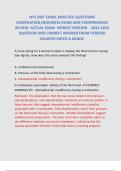NYS EMT EXAM ,PRACTICE QUESTIONS
COMPILATION,READINESS EXAM AND COMPREHESIVE
REVIEW ACTUAL EXAM NEWEST VERSION 2024-2025
QUESTION AND CORRECT ANSWER FROM VERIFIED
SOURCES RATED A GRADE.
A nurse caring for a woman in labor is reading the fetal monitor tracing
(see figure). How does the nurse interpret this finding?
A. Umbilical cord compression
B. Pressure on the fetal head during a contraction
C. Uteroplacental insufficiency during a contraction
D. Inadequate pacemaker activity of the fetal heart ✔✔CORRECT
ANSWER✔✔C. Uteroplacental insufficiency during a contraction
Rationale: The observation that the has nurse noted in this tracing is
late decelerations. Late decelerations constitute an ominous pattern in
labor because they suggest uteroplacental insufficiency, possibly
associated with a contraction. Early decelerations result from pressure
on the fetal head during a contraction. Variable decelerations suggest
umbilical cord compression. The term short-term variability refers to
the difference between successive heartbeats, indicating that the
natural pacemaker function of the fetal heart is working properly.
,A client who has undergone abdominal hysterectomy asks the nurse
when she will be able to resume sexual intercourse. The nurse tells the
client that sexual intercourse may be resumed:
A. At any time after the surgery
B. When menstruation resumes
C. When pelvic sensation and response to stimuli return
D. In about 6 weeks, when the vaginal vault is satisfactorily healed
✔✔CORRECT ANSWER✔✔D. In about 6 weeks, when the vaginal vault is
satisfactorily healed
Rationale: After abdominal hysterectomy, the client is instructed to
avoid sexual intercourse until the vaginal vault is satisfactorily healed.
This takes about 6 weeks. A woman who has undergone this procedure
must adjust to changes in the nature of pelvic sensations and stimuli
during sexual intercourse; however, this is not related to when sexual
intercourse may be resumed. The client will not have menstrual periods
after abdominal hysterectomy.
A nurse is preparing to care for a client who has undergone abdominal
hysterectomy for the treatment of endometrial cancer. The nurse
determines that the priority in the 24 hours after surgery is:
A. Monitoring the client for signs of returning peristalsis
B. Instructing the client in dietary changes to prevent constipation
C. Encouraging the client to deep-breathe, cough, and use an incentive
spirometer
,D. Encouraging the client to talk about the effects of the surgery on her
femininity and sexuality ✔✔CORRECT ANSWER✔✔C. Encouraging the
client to deep-breathe, cough, and use an incentive spirometer
Rationale: Care after abdominal hysterectomy includes maintenance of
a patent airway, promotion of circulation and oxygenation, promotion
of comfort, monitoring of output and drainage, promotion of
elimination, and discharge teaching with regard to medications and
therapeutic regimens. The priority is the maintenance of a patent
airway and promotion of oxygenation and circulation. Monitoring the
client for signs of returning peristalis, instructing her in dietary habits to
prevent constipation, and encouraging her to talk about the effects of
her surgery are also components of care after this surgery but are of
lower priority than encouraging the client to deep-breathe, cough, and
use an incentive spirometer.
A nurse is caring for a client with community-acquired pneumonia who
is being treated with levofloxacin (Levaquin). For which of the following
findings, indicating an adverse reaction to the medication, does the
nurse monitor the client?
A. Fever
B. Dizziness
C. Flatulence
D. Drowsiness ✔✔CORRECT ANSWER✔✔A. Fever
Rationale: Levofloxacin is an antibiotic of the fluoroquinolone class.
Pseudomembranous colitis is an adverse reaction associated with the
use of this medication. It is characterized by severe abdominal pain or
, cramps, severe watery diarrhea, and fever. Dizziness, flatulence, and
drowsiness are side effects of the medication.
A licensed practical nurse is reinforcing instructions to a client with
glaucoma who will be using acetazolamide (Diamox) daily. Which of the
following findings, an adverse effect, does the nurse instruct the client
to report to the physician?
A. Nausea
B. Dark urine
C. Urinary frequency
D. Decreased appetite ✔✔CORRECT ANSWER✔✔B. Dark urine
Rationale: Acetazolamide is a carbonic anhydrase inhibitor.
Nephrotoxicity and hepatotoxicity may occur, manifesting as dark urine
and stools, lower back pain, jaundice, dysuria, crystalluria, renal colic,
and calculi. Bone marrow depression may also occur as an adverse
effect. Nausea, urinary frequency, and decreased appetite are side
effects of the medication.
A nurse is caring for a client with a cuffed endotracheal tube who is
undergoing mechanical ventilation. Which intervention to prevent a
tracheoesophageal fistula, a complication of this type of tube, does the
nurse implement?
A. Frequent suctioning




